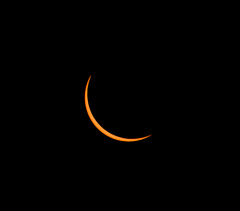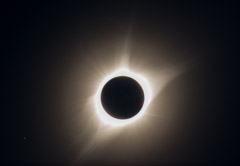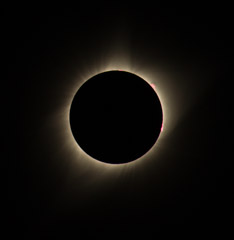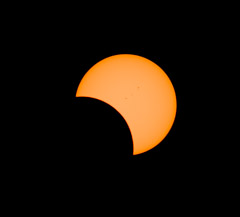I have witnessed and photographed several eclipses. Partial lunar eclipses, total lunar eclipses, partial solar eclipses and an annular solar eclipse ... and I even saw and photographed the recent transit of Venus across the Sun's face. None of those natural phenomena, indeed nothing I have ever witnessed, compares even closely with my experience of this total solar eclipse. All the hype one hears prior to each such relatively rare event is most definitely true. It is a truly awe-inspiring event to experience as daylight dims so completely while the Sun is so near the zenith. And then the last dazzling bright bead of the Sun's brilliant photosphere is extinguished by the inexorable motion of the Moon. At that moment the surrounding sky loses all pretense to its normal blue, turns inky black instead, and instantly the rays and streams of the Sun's corona leap out from the edge of the Moon into that black sky. A corona indeed! So delicate, so eerie, so other-worldly, so interesting! And so brief. A flurry of activity to make all the photographs I want ... and then ... a dazzling bright bead pops out along the western edge of the Sun, the black sky abuptly disappears, the diaphanous corona has vanished in the blaze of renewed light, and this remarkable show of totality is over. Too soon, too soon.
I know that I must chase another total eclipse for another chance to witness and experience it all again and in still more detail. Three things, I now know, are essential about it to me. It must occur at high altitude, high enough that the entire process, from first contact to last occurs at an high altitude, high angle above the horizon. At high altitudes, the turbulence of the air mass is minimal, so that fine details are not unduly masked by turbulent refraction as the light passes through it. And I must be able to "see" it all at a variety of magnifications. Eclipse glasses will show the event but cannot remotely rival the view with at least 10x - 12x magnification, for ony the magnified view enables one to clearly discern the subtle structures of the corona or sunspots and to possibly see any prominences which may be present. Third is that, although they are a distraction from directly experiencing the event, photographs can and often will show aspects which one misses due to both to their fleeting existence and to the fleeting existence of the totality itself. And the photographs will vividly rekindle my memory of that marvelous experience long after it has passed.
The main concrete results of my expedition to view and photograph the total solar eclipse are shown in the following four photographs and are described in captions. I selected these four images from among the 115 exposures that I made, because these show major features of this and all other total eclipses. I made all the photos between 11:43 and 13:12 MDT, according to the reasonably accurate clock in my D600. The 33 photos that I made during totality run from 11:47:57 through 11:49:56, a span of 1 minute and 59 seconds which nearly equals the entire time span of totality at my location. The four photos here represent the main aspects of the eclipse as I witnessed and photographed them. Note that north is a bit toward the upper right in these photos, as explained in the section below entitled "My Equipment".



